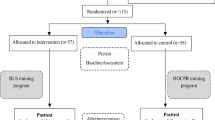Abstract
Drawings made by training children into cardiopulmonary resuscitation (CPR) during the special education week called “School otherwise” can be used as non-verbal means of expression and communication to assess the impact of such training. We analyzed the questionnaires and drawings completed by 327 schoolchildren in different stages of education. After a brief overview of the basic life support (BLS) steps and after watching a video presenting the dynamic performance of the BLS sequence, subjects were asked to complete a questionnaire and make a drawing to express main CPR messages. Questionnaires were filled completely in 97.6 % and drawings were done in 90.2 % cases. Half of the subjects had already witnessed a kind of medical emergency and 96.94 % knew the correct “112” emergency phone number. The drawings were single images (83.81 %) and less cartoon strips (16.18 %). Main themes of the slogans were “Save a life!”, “Help!”, “Call 112!”, “Do not be indifferent/insensible/apathic!” through the use of drawings interpretation, CPR trainers can use art as a way to build a better relation with schoolchildren, to connect to their thoughts and feelings and obtain the highest quality education
Similar content being viewed by others
References
Wissenberg M, Lippert FK, Folke F et al (2013) Association of national initiatives to improve cardiac arrest management with rates of bystander intervention and patient survival after out-of-hospital cardiac arrest. JAMA 310(13):1377–1384. doi:10.1001/jama.2013.278483
Colquhoun M (2012) Learning CPR at school—everyone should do it. Resuscitation 83(5):543–544. doi:10.1016/j.resuscitation.2012.03.004
Nielsen AM, Isbye DL, Lippert FK, Rasmussen LS (2014) Persisting effect of community approaches to resuscitation. Resuscitation 85(11):1450–1454. doi:10.1016/j.resuscitation.2014.08.019
Petriş A, Cimpoeşu D, Tatu-Chitoiu G et al (2010) Romanian Project “You can also save a life!”—teaching basic life support to school children: perception and involvement. Resuscitation 81(issue 2S):S104. doi:10.1016/j.resuscitation.2010.09.425
Georgiou M, Lockey AS (2013) ERC initiatives to reduce the burden of cardiac arrest: the European Cardiac Arrest Awareness day. Best Pract Res Clin Anaesthesiol 27(3):307–315. doi:10.1016/j.bpa.2013.07.004
Lockey AS (2014) European restart a heart day. Emerg Med J 31(9):696–697. doi:10.1136/emermed-2014-204111
Nolan JP, Soar J, Zideman DA, on behalf of the ERC Guidelines Writing Group European Resuscitation Council et al (2010) Guidelines for resuscitation 2010. Section 1. Executive summary. Resuscitation 81(10):1219–1276. doi:10.1016/j.resuscitation.2010.08.021
Benoit JA, Pettinati G (2015) Dessine-moi un mouton: décodez les messages de l’enfant par ses dessins. Les Éditions Québec-Livres, Québec
Zadeh ZF, Malik SM (2009) Expression of aggressive tendencies in the drawings of children and youth who survived the northern Pakistan earthquake. Eur J Psychol 5(2):64–81. doi:10.5964/ejop.v5i2.267
Foley YC, Mullis F (2008) Interpreting children’s human figure drawings interpreting children’s human figure drawings: basic guidelines for school counselors. Ga Sch Couns Assoc J 1(1):28–37
Burkitt E, Barrett M, Davis A (2009) Effects of different emotion terms on the size and colour of children’s drawings. Int J Art Ther 14:74–84. doi:10.1080/17454830701529567
Tatu-Chiţoiu G, Petriş A (2015) ‘Applied cardiology’: key words of the 2014–2017 National Programme of the Romanian Society of Cardiology. Eur Heart J 36(19):1144–1145
Aaberg AMR, Larsen CEB, Rasmussen BS, Hansen CM, Larsen JM (2014) Basic life support knowledge, self-reported skills and fears in Danish high school students and effect of a single 45-min training session run by junior doctors; a prospective cohort study. Scand J Trauma Resusc Emerg Med 22:24. doi:10.1186/1757-7241-22-24
Andelic S, Kalimanovska-Ostric D, Radojicic Z (2014) The significance of pre-existing knowledge of the latest guidelines for cardiopulmonary resuscitation in successful basic life support education of Belgrade sixth year medical students. Signa Vitae 9:37–46
Baldi E, Bertaia D, Contria E (2015) School children learn BLS better and in less time than adults. Resuscitation 88:e15–e16. doi:10.1016/j.resuscitation.2014.12.034
Bohn A, Van Aken HK, Möllhoff T et al (2012) Teaching resuscitation in schools: annual tuition by trained teachers is effective starting at age 10. A four-year prospective cohort study. Resuscitation 83(5):619–625. doi:10.1016/j.resuscitation.2012.01.020
Vass Z (2012) A psychological interpretation of drawings and paintings. The SSCA method: a systems analysis approach. Alexandra, Budapest
Acknowledgments
The research team would like to thank all the children and teachers from the following Romanian schools and high schools: Colegiul National “Costache Negruzzi”, Iaşi; Colegiul National”M. Sadoveanu”, Iaşi; Scoala nr. 6, Roşiorii de Vede (Teleorman County); Colegiul National “Vasile Lucaciu”, Baia Mare; Scoala Gimnaziala Ghimbav (Braşov County), and a Râmnicu Sărat school for joining this project.
Author information
Authors and Affiliations
Corresponding author
Ethics declarations
Conflict of interest
The authors declare that they have no conflict of interest.
Statement of human and animal rights
All procedures performed in studies involving human participants were in accordance with the ethical standards of the institutional and/or national research committee and with the 1964 Helsinki declaration and its later amendments or comparable ethical standards. This article does not contain any studies with animals performed by any of the authors.
Informed consent
Informed consent was obtained from all individual participants included in the study.
Rights and permissions
About this article
Cite this article
Petriş, A.O., Tatu-Chiţoiu, G., Cimpoeşu, D. et al. “You can also save a life!”: children’s drawings as a non-verbal assessment of the impact of cardiopulmonary resuscitation training. Intern Emerg Med 12, 365–369 (2017). https://doi.org/10.1007/s11739-016-1469-8
Received:
Accepted:
Published:
Issue Date:
DOI: https://doi.org/10.1007/s11739-016-1469-8




